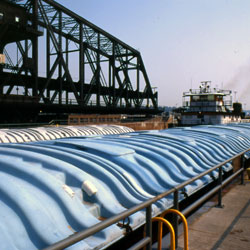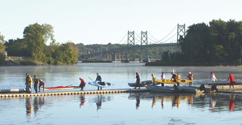
CLICK HERE for audio on who designed the double decked Government Bridge?
You are standing near the western end of the island called Rock Island. With a total of 946 acres, it is one of the largest islands in the Mississippi River. The island is home to the Rock Island Arsenal, established in 1863. This U.S. Army facility remains active and currently employs over 6,000 people from the Quad Cities area.
In 1969, the arsenal was placed on the National Register of Historic Places, and in 1989 the original buildings were designated as National Historic Landmarks. Today, the Rock Island Arsenal is our nation's largest government owned and operated arsenal.
Prior to the establishment of the arsenal, this island was home to Fort Armstrong. Built in 1816 near the western tip of the island, the fort was named in honor of John Armstrong who was Secretary of War at the time. The island’s strategic position provided command of both channels of the Mississippi River. During its first few years, the fort was an important gathering place on the American frontier; and in 1832 is served as the military headquarters during the Black Hawk War. If you turn and look just south down the bike trail you’ll see a replica of one of the fort’s blockhouses, which was erected in 1916 for the fort's centennial celebration.
This is the Government Bridge, which connects Rock Island with Davenport, Iowa, and was built in 1896 on the same piers as the first Government Bridge of 1872. It is a double-decker bridge with two sets of railroad tracks above and a roadway below, and it has a swing span that can rotate 360 degrees in either direction allowing for river traffic to pass through. This combination makes the Government bridge the only one of its kind in the United States.
Ralph Modjeski, who would become one of this country’s most honored bridge builders, designed and supervised the construction of the Government Bridge. Modjeski later designed more than 50 bridges, including Mississippi River bridges at Moline, Keokuk, St. Louis, Memphis, and New Orleans.
Adjacent to the bridge is Lock and Dam 15, which is operated by the U.S. Army Corps of Engineers. It was the largest roller dam in the world when opened in 1934, spanning a total distance of 1,203 feet. Included are nine non-overflow gates and two overflow gates. The dam controls navigation levels from here upstream to Lock and Dam 14 at LeClaire, Iowa. An average of 28 billion gallons of water flows down river each day over the dam’s rollers.
The turbulent waters directly below Lock and Dam 15 provide an excellent winter feeding site for hundreds of American Bald Eagles. They swoop down to grab fish that are stunned during their passage under the roller dam. In March, the eagles are joined by migrating giant White Pelicans, which have 110-inch wing spans. Forty percent of all North American waterfowl and 35 percent, or 326, of all bird species in North America migrate through this Mississippi River flyway corridor.
With appropriate photo ID, bicyclists with helmets, pedestrians, and visitors by car are always welcome at the Mississippi River Visitors Center, just inside the Arsenal security gates. This facility gives an excellent view of towboats and the locking process as they pass through the locks.









